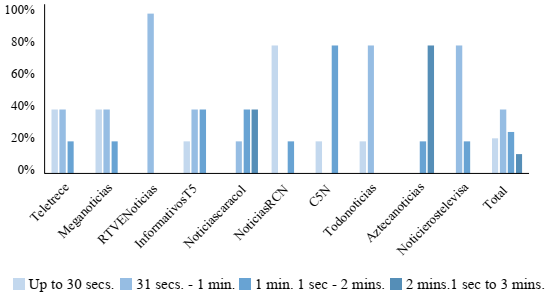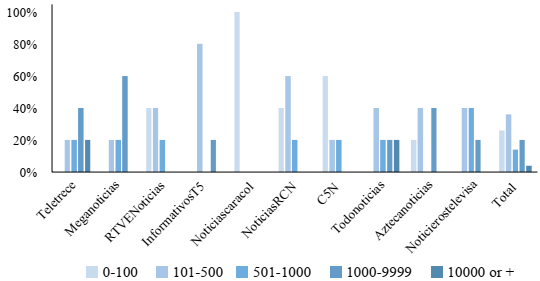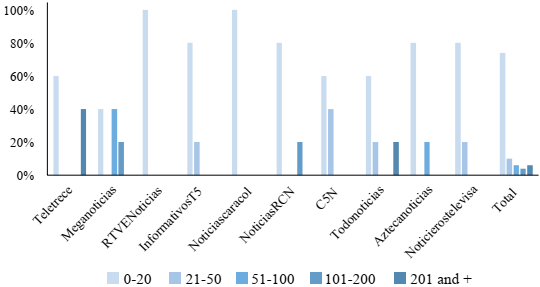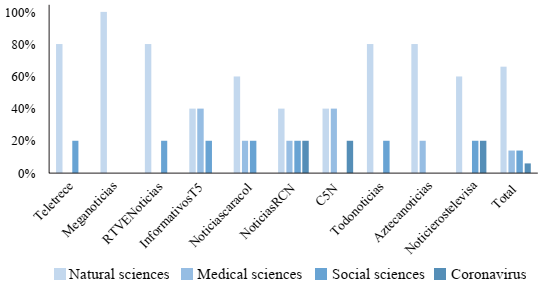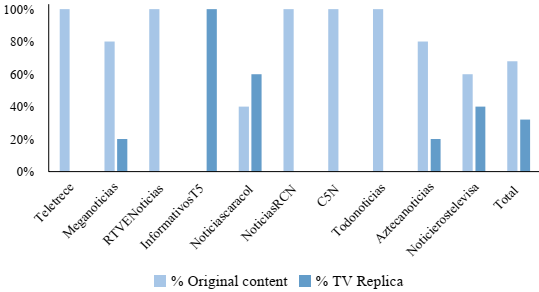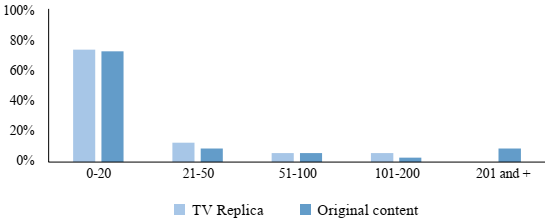Services on Demand
Journal
Article
Indicators
-
 Cited by SciELO
Cited by SciELO -
 Access statistics
Access statistics
Related links
-
 Similars in
SciELO
Similars in
SciELO
Share
Comunicación y sociedad
Print version ISSN 0188-252X
Comun. soc vol.20 Guadalajara 2023 Epub Apr 17, 2023
https://doi.org/10.32870/cys.v2023.8441
Articles
General theme
From TV to TikTok: New audiovisual formats to communicate about science1
*Universidad de Granada, España. jmartinne@correo.ugr.es, mtrillo@ugr.es, molvera@ugr.es
This paper shows how ten television news programs use TikTok to disseminate science news, analyzing how the platform’s own language is applied. Through the application of an evaluation checklist, the adaptation of television content is analyzed and the audiovisual opportunities offered by this social network are assessed. The results show that short videos produce greater interaction with users and that news channel profiles are not sufficiently taking advantage of the particular language that this social network allows.
Keywords: Transmedia storytelling; audiovisual; science journalism; social media; TikTok
Este artículo da a conocer la forma en que diez programas informativos de televisión utilizan TikTok para difundir noticias de ciencia, analizando cómo aplican el lenguaje propio que tiene la plataforma. Mediante la aplicación de una checklist de evaluación, se analiza la adaptación del contenido televisivo y se valoran las oportunidades audiovisuales de esta red social. Los resultados evidencian que los videos cortos producen una mayor interacción con los usuarios y que los perfiles de canales de noticias no están aprovechando las particularidades de TikTok.
Palabras clave: Narrativas transmedia; audiovisual; periodismo científico; redes sociales; TikTok
Este artigo revela a forma como dez telejornais usam o TikTok para divulgar notícias científicas, analisando como aplicam a linguagem própria da plataforma. Através da aplicação de um checklist de avaliação, analisa-se a adaptação de conteúdos televisivos e avaliam-se as oportunidades audiovisuais desta rede social. Os resultados mostram que os videos curtos produzem maior interação com os usuários e que os perfis dos canais de notícias não estão aproveitando as particularidades do TikTok.
Palavras-chave: Narrativas transmídia; audiovisual; jornalismo científico; redes sociais; TikTok
Introduction
The use of videos has become an effective tool for communicating science to the community, especially in relation to those audiovisual products that come from the social networks (Kippes, 2021), to which they have been established as a source not just in informative but also educational terms, which contributes to the popularization of this activity (Impey et al., 2018). The communications media of today are strongly committed to incorporating contents associated with audiovisual language. It is thus common to observe the existence of newspapers adapting their stories to podcasts or documentary videos, radio stations broadcasting via streaming, and native digital platforms that see the resource as an efficient strategy for reaching new and more connected audiences (Moreno-Espinosa et al., 2021; Trillo-Domínguez & Alberich-Pascual, 2020).
Illustrative capacity and the possibility of conceptualizing elements that can frequently be complex affords great value to the use of videos for communicating science and technology. At first, the audiovisual contribution to scientific dissemination was limited to what it was possible to offer on the television via news, reports, documentaries and even mixtures of programs associated with entertainment or culture (Ali, 2014). The possibility of reaching a large number of audiences made television fertile ground for communicating scientific aspects (Hut et al., 2016), thus having a positive impact on the public and facilitating a greater understanding as regards this type of content (Mason-Wilkes, 2020).
Nevertheless, one aspect that is relevant in terms of the communication of science via television is the convenience of the appropriate incorporation of diverse elements that allow new content to be offered, but at the same time avoid boring or saturating the public with information (Jaki, 2018). It is therefore essential to prepare the audience as regards what is going to be told and shown, adapting scientific language to avoid it being a barrier for the spectator (Ali, 2014). One of the criticisms aimed at science television programs is the unidirectional nature of the flow of information; in other words, there are reduced instances for the participation of the audience, which are denied the possibility of being a part of the process of the creation, broadcast or evaluation of a news story (López Aguilar, 2018). In the face of this, tools such as the Internet have helped to increase the involvement of the public and enable it to be an active part of the processes (Olvera-Lobo & López-Pérez, 2014).
Technological evolution, especially in regards to the Internet and the mobile telephone, gradually opened the doors to audiovisual communication not just relying on the television in order for it to occur (Moreno-Espinosa et al., 2021). The fact of being able to choose what to watch when you want (Martišius, 2018), changed the rules of the game for the way in which audiences consume audiovisual products. Social networks have played a fundamental role in increasing this “audiovisual independence”, and have facilitated the creation of audio and video content (Fernández-de-Arroyabe-Olaortua et al., 2018). Some studies show that, at present, audiovisual products are those that are showing the most growth in terms of importance (Costa-Sánchez & Túñez-López, 2019) and the consumption of online videos is at its highest levels (Boy et al., 2020).
Furthermore, the importance of YouTube should not be understated in the reaching of these levels of consumption, with it today constituting the most used platform for online video (Torres-Toukoumidis & Marín-Gutiérrez, 2020) and an ideal network for users and disseminators to create educational content aimed at the diverse audiences on the platform. YouTube is progressively being constructed as an informal, attractive, emerging and essential platform for scientific literacy (Vizcaíno-Verdú et al., 2020).
Video is undoubtedly one of the main actions carried out or seen by young people on the Internet (Blanco & Palomo, 2021). Many -who live interconnected and watch on average close to 70 videos per day (Cervi, 2021)-, are the protagonists of this phenomenon. These individuals are slowly moving away from traditional media, in this way replacing the reign of television when consuming audiovisual products (Navarro Robles & Vázquez Barrio, 2020). Taking these circumstances into consideration, that is, a high consumption of audiovisual products on the part of this age group segment and the benefits that communicating via audio and video brings in a digital age, it was not so outrageous to think that new applications would begin to gain ground in this audiovisual production.
It is in this context that TikTok makes its appearance, currently one of the most utilized social networks that has undergone considerable growth in users following the pandemic (Basch et al., 2021). It is thus an application that achieved the blend of a series of characteristics to attract an audience, especially young, permitting the creation of videos that are short, interactive, multimedia and familiar (Martín Ramallal & Micaletto Belda, 2021). The use of filters, the possibility of organizing challenges with other users, the humorous touch that prevails in numerous videos, the importance given to dances, amongst other characteristics (Cervi, 2021) make TikTok an application with its own language, which has gained ground among the population.
In turn, the transmedia possibilities this social network provides, with actions that seek interaction between creators, the extensive use of multiplatform elements to publish content and the co-creation of stories, the use of collaborative journalism to create content and the development of new narratives (Chobanyan & Nikolskaya, 2021) also make this application a platform of noteworthy interest for study. In this way, recent studies reveal how the network has been applied to the communication of science, where physical demonstrations and Covid-19 related topics (Hayes et al. 2020; Li et al., 2021; Zeng et al; 2020), are the main strategies used by educators to discuss scientific aspects.
Taking into account the benefits arising from the platform, it was not long before television channels began using it to capture new audiences (Vázquez-Herrero et al., 2021). Beyond the fact that it is not the most popular application for finding news, TikTok is unarguably a social network with high potential for attracting young audiences who do not necessarily consume television (Chobanyan & Nikolskaya, 2021).
The objectives of the study presented here are orientated towards analyzing the audiovisual opportunities this type of platform offers, determining the strategies applied by television news channels to adapt their own languages to TikTok, assess the possibilities of creating content associated with the transmedia narratives offered, and identify the way in which television news media are publishing their science stories on it. Below is a description of the study carried out to reach these objectives.
Material and methods
For the purposes of carrying out the study, a detailed bibliographical review was made for the thematic domain of the research object. Furthermore, in order to provide an overall view of the state of publications on this topic, information was gathered from databases of reference such as Web of Science (WoS) and Scopus. Thus, search strings were created adapted to the specific interrogative language of each information recovery system consulted, which included key concepts such as “science journalism”, associated with terms like “audiovisual”, “television”, “social networks” and “video”, and concepts such as “TikTok” with “science” and “television” or “transmedia” with “science”. The searches were carried out in English and the chronological period was delimited to those publications appearing between 2015 and 2021. This review is based upon the ideas put forward by Codina (2020), in regards to this type of analysis being an effective way of comparing ideas or concepts about a discipline, which permits the identification of tendencies in the publications in the years covered by the study, the publication language, the origin of the authors, and the core thematic ideas.
Additionally, an analysis was carried out within TikTok of the profiles for communications media that use the channel for the dissemination of science news, categorizing the posts created and establishing their degrees of usage. The sample of communications media included in this study comprises Ibero-American news television programs. For the configuration of the study sample, selection criteria for the TikTok television profiles were applied that fulfilled the following requirements at the moment the data were collected: 1) they were verified and active, 2) had over 30 thousand followers and 3) at the time the study was developed had accumulated over 100 posts. The data collection was carried out by the researchers of this paper, specialists in information, communication and journalism technologies.
Ten profiles of news programs from Ibero-America were selected, specifically from Argentina, Chile, Mexico, Colombia and Spain, with the purpose of identifying how they carried out science communication via the application and of offering a general overview of the situation in different geographical parts of Ibero-America. Table 1 details the characteristics of the profiles selected in relation to the established criteria. Furthermore, the date on which the profile made its first post is indicated as a reference, along with the number of likes that, at the time of the study, the television news program had received.
Table 1 Characteristics of news program profiles on TikTok
| User profile | Country of Origin | First post on TikTok | Number of followers | Number of posts | Number of Likes | Verification |
|---|---|---|---|---|---|---|
| @Teletrece | Chile | 21-08-2019 | 135.3K | 197 | 982.2K | Yes |
| @Meganoticias | Chile | 23-02-2020 | 767.7K | 459 | 8.7M | Yes |
| @RTVENoticias | Spain | 10-02-2021 | 67.8K | 637 | 1.2M | Yes |
| @InformativosT5 | Spain | 14-04-2021 | 191.4K | 706 | 4M | Yes |
| @Noticiascaracol | Colombia | 03-11-2021 | 95.4K | 231 | 360.9K | Yes |
| @NoticiasRCN | Colombia | 01-11-2021 | 186.4K | 174 | 1M | Yes |
| @C5N | Argentina | 06-10-2021 | 83.4K | 423 | 563K | Yes |
| @Todonoticias | Argentina | 22-07-2020 | 1.31M | 1036 | 22.3M | Yes |
| @Aztecanoticias | Mexico | 20-01-2021 | 1.89M | 1318 | 20.5M | Yes |
| @Noticierostelevisa | Mexico | 12-02-2021 | 1.26M | 2991 | 12M | Yes |
Source: Own creation.
For the development of this analysis a checklist was created (Table 2) as a tool for characterizing the use of TikTok as a communication platform via the profiles analyzed. This checklist considered works of note, published in journals indexed on the WoS and Scopus databases, which show important elements when undertaking an analysis of how posting is carried out on the social network. Thus, the conditions for establishing parallels between TikTok and television were evaluated (Vázquez-Herrero et al., 2021) and as a result of the indicated study works were analyzed that permitted the establishment of categories for the science videos and the content that predominates on this social network (Zeng et al., 2021), as well as considering studies focused on engagement with users (Li et al., 2021), evaluating the quantity of likes or the times a post had been shared.
Table 2 Checklist for the evaluation of TikTok use
| Profile and date of post | ||||
|---|---|---|---|---|
| Date and duration | 1 | Up to 30 secs. | ||
| 2 | 31 secs. - 1 min. | |||
| 3 | 1 min. 1 sec - 2 mins. | |||
| 4 | 2 mins.1 sec to 3 mins. | |||
| Number of likes | 1 | 0-100 | ||
| 2 | 101-500 | |||
| 3 | 501-1 000 | |||
| 4 | 1 000-9 999 | |||
| 5 | 10 000 or + | |||
| Number of comments | 1 | 0-20 | ||
| 2 | 21-50 | |||
| 3 | 51-100 | |||
| 4 | 101-200 | |||
| 5 | 201 and + | |||
| Number of shares | 1 | 0-20 | ||
| 2 | 21-50 | |||
| 3 | 51-100 | |||
| 4 | 101-200 | |||
| 5 | 201 and + | |||
| Purpose of video | Informative | |||
| Explicative-Educational | ||||
| Entertainment-Parody | ||||
| Challenge-Duet | ||||
| Predominant content | Natural sciences | |||
| Medical sciences | ||||
| Social sciences | ||||
| Technology | ||||
| Coronavirus | ||||
| Other | ||||
| The video is a replica of traditional television content | Yes - No | |||
| Indicators | Degree of usage | |||
| Null | Low | Medium | High | |
| The video includes animations such as GIFs, filters or texts | ||||
| The video uses background music | ||||
| The video includes commentary or lip-sync | ||||
| Comedy resources are used in the video | ||||
| A variety of hashtags appropriate for the news story are included | ||||
| Protagonists or characters who tell the story are seen in the video | ||||
| The video has a variety of scenes and has been edited | ||||
| The video permits cocreation or there is an invitation to create new stories | ||||
| Other users are tagged in the video | ||||
| The user profile responds to the comments made by the audiences and interacts with followers | ||||
Source: Own creation.
To create this table, works were taken as a reference that recognize how important visual effects are in a TikTok message, especially those related to GIFs, multiple screens and effects templates (Vázquez-Herrero et al., 2020). The analysis and consolidation of the main elements of these reference works resulted in the proposed checklist, which furthermore includes items specific to transmedia narratives, with the aim of determining their use. The levels of what is here referred to as minimal adaptation to TikTok are characterized in the checklist in a gradual manner (Martin-Neira et al., 2022b), where it is established that an object is: a) null: when the criterion is not applied or developed; b) low: when the content covers under 50% of the length of the video; c) medium: when there is a use of between approximately 50% up to 90% and; d) high: when the criterion is fulfilled in over 90% of the video.
The analysis was carried out in the period comprising July 2021 and January 2022, to which five science posts were selected at random from each of these profiles over these dates (Vázquez-Herrero et al., 2020).
Results
The searches realized on the WoS and Scopus databases were carried out delimiting and grouping the main concepts related to this study. After eliminating the duplicates, Scopus recovered 293 articles that responded to the search criteria. In WoS, for its part, 237 documents were recovered after applying the duplicate filter.
In both databases the majority of the publications came from Europe (followed by North America) and were in English. As well as the more generic concepts, such as “science journalism”, the queries that produced the highest number of results were those related to “transmedia” and “science”. Moreover, it is observed that in the previous year (2021) it seems there was an increase in interest for these topics, as a higher number of publications were detected.
Below are the results of the analysis of the news channel TikTok profiles and how science news is presented on the platform. In this way, we have determined the average duration of each publication, the use of the audiovisual language of TikTok, the interaction produced with the audiences, and other elements characterized in Table 2.
TikTok as a platform for science news: a language to discover
Firstly, we analyzed the duration of each video, and the number of likes and the number of comments thereon. At a general level, the most habitual time range is that covering the length of “31 seconds to 1 minute”, reaching 40% of the posts analyzed. Following this, the most used group is that responding to videos with a length of “1 minute 1 second, to 2 minutes”, with 26%. On the other hand, the shortest videos, those lasting “up to 30 seconds”, stood at 22%. Finally, 12% of the total number of videos observed exceeded the duration of “2 minutes and 1 second, up to 3 minutes” (Figure 1).
In relation to the number of likes (Figure 2) accumulated by the analyzed posts it can be observed that, while 26% fail to get more than 100 likes per post, 36% have a range of likes of between 101 to 500. In contrast, 20% of the videos published on the profiles are placed in a group of between 1 000 and 9 999 likes, whereas just 4% of the content analyzed reached more than 10 000.
There is not much interaction as regards the analyzed posts, taking into account the comments made by users, given 74% maintain a frequency of 0 to 20 comments. It is noteworthy that only 6% of the posts exceed 201 (or more) written interactions with users (Figure 3).
In terms of the objective of the videos (Figure 4), 62% of the total posts had a more informative tone, that is, following the traditional style of an audiovisual news story. On the other hand, 38% were explicative-educational in nature, with a freer style when informing. In the sample analyzed no “challenge” or parody type post was detected.
In contrast to the content shown in the videos (Figure 5), the majority of the analyzed posts respond to natural science news, standing at 66% of the total. This is followed by posts associated with medical and technology science (both with 14%), with 6% of the total examined being about coronavirus. It is worth mentioning that the analysis was carried out over a period in which there was still a reduced number of infections in Ibero-America, there only being an increase in January 2022 (Ibero-American General Secretariat, 2022). There are no videos on social science or which belong to the others category, such as humanities.
Comparison between content that does or does not replicate television news
One of the most interesting aspects brought to light when discovering the results of this sample is that 32% of the posts were exact replicas of the content presented on television; in other words, some profiles only posted a video with text or a special background, but there was no minimal adaptation to TikTok-specific audiovisual language, instead a post of the same story that appeared on the news channel (Figure 6).
In relation to this datum, it is necessary to indicate that all of the posts with a duration exceeding 2 minutes 1 second, the most extensive group in our sample, are videos that respond to a content that is a replica of a television story. Furthermore, 76.5% of the original posts on the platform and that use the language of TikTok have a duration of less than 1 minute (Figure 7).
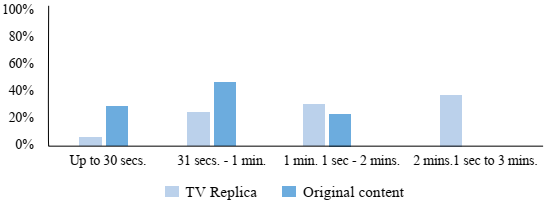
Source: Own creation.
Figure 7 Comparison of “duration” for contents that are replicas of TV or originals
Another circumstance observed when making the distinction between this type of categorization, according to the checklist (Table 2), is that the two publications with over 10 000 likes are posts with original content adapted to the language of TikTok. Moreover, both have a duration of under 1 minute, following the tendency of that which occurs with this type of post (Figure 8).
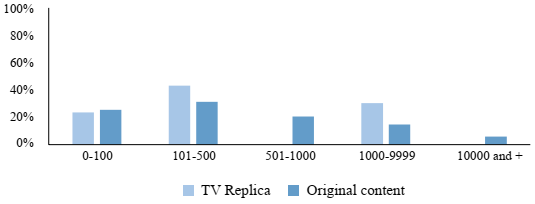
Source: Own creation.
Figure 8 Comparison of likes for contents that are replicas of TV or originals
However, these same results show that, as is also the case with the number of accumulated likes, the type of post does not guarantee a higher number of comments. Thus, 75% of posts that are replicas of other television news stories do not exceed 20 comments, similar numbers to those referring to content that is original or adapted to the language of TikTok, given that 73.5% of this type of post appears under the 20 comment barrier (Figure 9).
Adaptation to the language of TikTok
In relation to the indicators that this study determined as minimum elements for being used on TikTok (Figure 10), it can be highlighted, at a general level, that a large part of the aspects considered are not used in the majority of the posts. For example, 72% of the posts do not contain humorous resources and the use of animations (GIFs, filters or written texts) is low or null in 60% of them.
In relation to the processes directly related to interaction with other users, in practically 100% of the productions there was no invitation for users to cocreate their own story, due to the absence of greater transmedia possibilities in the contents. This seems to be the case also due to the inclusion of reduced tags of other users, which in some way does not promote the creation of new posts.
Interaction is likewise something that this analysis has found to be scarce, given that in the large majority of the posts there is no response to the comments that accompany them and there are no relationships with followers. Added to this is the fact that 42% of the posts fail to include any type of hashtag associated with the news story published, which may come to reduce the possibilities of it going viral.
Discussion and conclusions
Social networks have today become essential platforms for journalists and the media in general to communicate all types of news (Lewis & Molyneux, 2018), and the dissemination of scientific content is not unconnected to such actions, making the topic more recurrent and increasing the number of accounts that post on science via such channels (Davies et al., 2021). One example is TikTok, a social network that is “random, without greater context and with fleeting content” (Cervi, 2021, p.199), which has also become a valuable platform for accessing all types of information (Vázquez-Herrero et al., 2020).
A fundamental element for the success of this type of application is related to the audiovisual formats used and the opportunities these platforms offer. An increase in videos with a duration of under 5 minutes has been observed in recent years (Kaye et al., 2021) and, although different studies have noted that the preference towards a short or long video will depend on the “time and situation” (Swain & Waddington, 2020, p.7), it is thought that the shorter the video, the more interaction is produced among users (Guo et al., 2014), and there is even a greater retention of information (Slemmons et al., 2018). Therefore, the average duration observed in the videos analyzed for this work, which is found in the “31 seconds to 1 minute” group, can be considered an appropriate range for capturing audiences. Nevertheless, it should not be ignored that the video should immediately stand out, as the initial seconds are essential for capturing audiences (Wang, 2021), and this may even favor the obtaining of a higher number of likes and comments (Parabhoi et al., 2021). This tendency is shown in this study, as the posts with the highest number of likes have a duration of under one minute.
But it is not just the duration of the video that is important for success on a platform such as TikTok; it must also be well-produced and use all of the potential offered therein. The possibility of integrating texts, image and sound is one of the keys to the sustained increase of users on the platform (MacKinnon et al., 2021); however, this study does not envisage a positive union of these aspects. Chobanyan & Nikolskaya (2021) state in their investigation into the potential of TikTok for televised news that the ideal situation is for the news stories presented on the application to be short, but also visually and textually attractive, which are actions that are not applied by the majority of the profiles this research paper has investigated.
Over 30% of the scientific content analyzed on TikTok is a reproduction of a television news item, with no adaptation to the specific language of this social network. The latter may be associated with a concept that could be known as replicant journalism (Costa-Sánchez et al., 2015), which refers to the fact that the same news content is offered despite being aimed at different users and on different platforms. In the specific case of TikTok, the news programs that have started to experiment with this platform are encountering difficulties in adapting their content to it (Peña-Fernández et al., 2022), and the majority of the channels lack an appropriate strategy (Vázquez-Herrero et al., 2021), which brings them to replicate content that fails to take advantage of the particular language and narrative possibilities of a social network as recent as TikTok.
Another potentiality that should be taken advantage of refers to the use of transmedia narratives. TikTok and visual social networks in general favor interactivity, the development of virtual communities, the breakup of unidirectionality, and the creation of content (Suárez-Álvarez & García-Jiménez, 2021). On the other hand, in the analysis carried out, there is no discovery of a greater interest on the part of the profiles in encouraging their followers to create stories on the content they develop, or even to comment on what they think about the information offered. Nor do the news programs use challenges and duets, elements that are characteristic of TikTok and which favor co-creation. This may reduce possibilities of interaction with audiences, as it has been documented that this type of action favors engagement and user comments (Vásquez González, 2021). Another way of favoring these encounters between content creators and their followers could be via trending videos and the most used music or song extracts, as they can become effective transmedia tools for achieving success on the platform (Vizcaíno-Verdú & Aguaded, 2022). Using transmedia strategies and disruptive tools produced within these formats may favor the communication of science and interaction with audiences (Martin-Neira et al., 2022a).
And this point is key. Perhaps one of the most extensively studied aspects on this application is the level of interactions achieved with audiences and how to improve engagement. For instance, the use of hashtags increases the possibility of obtaining more likes and views (Chobanyan & Nikolskaya, 2021); however, the results of this study indicate that 60% of the publications analyzed do not use hashtags, or do so scarcely. Interaction with users should not be seen simply as a challenge for fulfilling reachable objectives, it should be constructed deliberately and aspire to create communities in order to, in this way, build loyalty among audiences who will be waiting for the contents and messages created by each profile.
Another aspect worth drawing attention to is that the results offer behaviors that are parallel to those that occur with social sciences given that, as has been documented (Eizmendi-Iraola & Peña-Fernández, 2021; Olvera-Lobo & López-Pérez, 2015), this type of knowledge is not usually taken into consideration or is diverted to other sections when disseminating science news. Our investigation has not detected posts relating to this discipline, which reinforces the idea that social sciences and humanities are not normally fields of study that are dealt with more in science sections.
Despite TikTok being at the pinnacle of its popularity and having become a global phenomenon, no clear strategies yet exist on how to publish science news on this social network, and this is even more the case as regards experiences originating from Spanish speaking countries. In contrast, the news media are still at an exploration stage, discovering what tools this application provides and experimenting with the particular language it offers (Sidorenko-Bautista et al., 2021). The application has such unique characteristics that the content created should be original (Peña-Fernández et al., 2022) and in a specific audiovisual format (Negreira-Rey et al., 2022).
Although this investigation adjusts to a reduced number of profiles and publications, which could be interpreted as a limitation of analysis, the authors consider that the sample size does not take away validity from the results, given that it constitutes an initial approach to the use of TikTok as a tool for communicating science news and permits us to obtain a representative view of the current situation. In this manner, this study helps to create a starting point for future research that contributes towards a deeper understanding of this novel social network from different perspectives. Future analyses should focus, among other aspects, on the identification and description of the best strategies for developing scientific disseminating on TikTok.
REFERENCES
Ali, M. S. (2014). Television as a Medium of Science Communication. En L. Wee Hin & R. Subramaniam (Eds.), Communicating Science to the Public. Opportunities and Challenges for the Asia-Pacific Region (pp. 277-292). Springer. https://doi.org/10.1007/978-94-017-9097-0_17 [ Links ]
Basch, C. H., Mohlman, J., Fera, J., Tang, H., Pellicane, A. & Basch, C. E. (2021). Community mitigation of covid-19 and portrayal of testing on tiktok: Descriptive study. JMIR Public Health and Surveillance, 7(6), 1-7. https://doi.org/10.2196/29528 [ Links ]
Blanco, S. & Palomo, B. (2021). Journalistic rigor and consistency the keys to the success of Spanish journalists on YouTube. Estudios sobre el Mensaje Periodístico, 27(4), 1043-1051. https://doi.org/10.5209/esmp.78143 [ Links ]
Boy, B., Bucher, H. J. & Christ, K. (2020). Audiovisual Science Communication on TV and YouTube. How Recipients Understand and Evaluate Science Videos. Frontiers in Communication, 5(December), 1-18. https://doi.org/10.3389/fcomm.2020.608620 [ Links ]
Cervi, L. (2021). Tik Tok and generation Z. Theatre, Dance and Performance Training, 12(2), 198-204. https://doi.org/10.1080/194439 27.2021.1915617 [ Links ]
Chobanyan, K. & Nikolskaya, E. (2021). Testing the waters: Tiktok’s potential for television news. World of Media, 2021(3), 62-88. https://doi.org/10.30547/worldofmedia.3.2021.3 [ Links ]
Codina, L. (2020). How to do traditional or systematic bibliographic reviews using academic databases. Revista ORL, 11(2), 139. https://doi.org/10.14201/orl.22977 [ Links ]
Costa-Sánchez, C., Rodríguez-Vázquez, A. I. & López-García, X. (2015). From transmedia to repurposing journalism. Elpais.com press coverage about case of ebola in Spain. Profesional de la Información, 24(3), 282-290. https://doi.org/10.3145/epi.2015.may.08 [ Links ]
Costa-Sánchez, C. & Túñez-López, M. (2019). Audiovisual Content in Social Media. A Comparative Analysis of Facebook and Youtube. Fonseca, Journal of Communication, (19), 223-236. https://doi.org/10.14201/fjc201919223236 [ Links ]
Davies, S. R., Franks, S., Roche, J., Schmidt, A. L., Wells, R. & Zollo, F. (2021). The landscape of European science communication. Journal of Science Communication, 20(03), A01. https://doi.org/10.22323/2.20030201 [ Links ]
Eizmendi-Iraola, M. & Peña-Fernández, S. (2021). Disappeared or hidden? Analysing the presence of social sciences and humanities in online versions of The Guardian, El País and Público. European Public & Social Innovation Review, 6(1), 56-69. https://doi.org/10.31637/epsir.21-1.5 [ Links ]
Fernández-de-Arroyabe-Olaortua, A., Lazkano-Arrillaga, I. & Eguskiza-Sesumaga, L. (2018). Digital natives: Online audiovisual content consumption, creation and dissemination. Comunicar, 26(57), 61-69. https://doi.org/10.3916/C57-2018-06 [ Links ]
Guo, P. J., Kim, J. & Rubin, R. (2014). How Video Production Affects Student Engagement: An Empirical Study of MOOC Videos. Proceedings of the first ACM conference on Learning @ scale conference (L@S ’14), 41-50. https://doi.org/10.1145/2556325.2566239 [ Links ]
Hayes, C., Stott, K., Lamb, K. J. & Hurst, G. A. (2020). “Making Every Second Count”: Utilizing TikTok and Systems Thinking to Facilitate Scientific Public Engagement and Contextualization of Chemistry at Home. Journal of Chemical Education, 97(10), 3858-3866. https://doi.org/10.1021/acs.jchemed.0c00511 [ Links ]
Hut, R., Land-Zandstra, A. M., Smeets, I. & Stoof, C. R. (2016). Geoscience on television: A review of science communication literature in the context of geosciences. Hydrology and Earth System Sciences, 20(6), 2507-2518. https://doi.org/10.5194/hess-20-2507-2016 [ Links ]
Impey, C., Wenger, M., Austin, C., Calahan, J. & Danehy, A. (2018). Videos for Astronomy Education and Outreach. Capjournal, (24), 32-39. https://www.capjournal.org/issues/24/24_32.pdf [ Links ]
Jaki, S. (2018). Terms in popular science communication: The case of TV documentaries. Hermes. Journal of Language and Communication in Business, (58), 257-272. https://doi.org/10.7146/hjlcb.v0i58.111689 [ Links ]
Kaye, D. B. V., Chen, X. & Zeng, J. (2021). The co-evolution of two Chinese mobile short video apps: Parallel platformization of Douyin and TikTok. Mobile Media and Communication, 9(2), 229-253. https://doi.org/10.1177/2050157920952120 [ Links ]
Kippes, R. (2021). The video-article as a key narrative resource for science communication in new digital environments. Jcom América Latina, 04(01), 6. https://doi.org/10.22323/3.04010206 [ Links ]
Lewis, S. C. & Molyneux, L. (2018). A decade of research on social media and journalism: Assumptions, blind spots, and a way forward. Media and Communication, 6(4), 11-23. https://doi.org/10.17645/ mac.v6i4.1562 [ Links ]
Li, Y., Guan, M., Hammond, P. & Berrey, L. E. (2021). Communicating covid-19 information on TikTok: A content analysis of TikTok videos from official accounts featured in the covid-19 information hub. Health Education Research, 36(3), 261-271. https://doi.org/10.1093/her/cyab010 [ Links ]
López Aguilar, J. L. (2018). YouTube like tool for the construction of the society of the knowledge. ReHuso: Revista de ciencias humanísticas y sociales, 3(1), 1-16. https://doi.org/10.33936/rehuso.v3i1.1225 [ Links ]
MacKinnon, K. R., Kia, H. & Lacombe-Duncan, A. (2021). Examining TikTok’s Potential for Community-Engaged Digital Knowledge Mobilization with Equity-Seeking Groups. Journal of Medical Internet Research, 23(12). https://doi.org/10.2196/30315 [ Links ]
Martin-Neira, J.-I., Trillo-Domínguez, M. & Olvera-Lobo, M.-D. (2022a). Digital journalism and transmedia narratives in the communication of science: From disruption to reinvention. En R. Pettinger, B. B. Gupta, A. Roja, & D. Cozmiuc (Eds.), Handbook of Research on Digital Transformation Management and Tools (pp. 531-555). IGI Global. https://doi.org/10.4018/978-1-7998-9764-4.ch024 [ Links ]
Martin-Neira, J.-I., Trillo-Domínguez, M. & Olvera-Lobo, M.-D. (2022b). The dissemination of scientific news in the Chilean press: Analysis of digital and printed publications on coronavirus. En M. Álvarez-Chávez, G. Rodríguez-Garay, & S. Husted (Eds.), Communication and plurality in a divergent context (pp. 800-829). Dykinson S.L. [ Links ]
Martín Ramallal, P. & Micaletto Belda, J. P. (2021). Tiktok, gen z symbiotic network for augmented reality and immersive advergaming. Revista de Comunicación, 20(2), 223-242. https://doi.org/10.26441/RC20.2-2021-A12 [ Links ]
Martišius, M. (2018). Television goes mobile: The transformation of the audio-visual media market. Informacijos Mokslai, (84), 62-80. https://doi.org/10.15388/im.2018.84.13 [ Links ]
Mason-Wilkes, W. (2020). Divine DNA? “Secular” and “Religious” representations of science in nonfiction science television programs. Zygon, 55(1), 6-26. https://doi.org/10.1111/zygo.12574 [ Links ]
Moreno-Espinosa, P., Román-San Miguel, A. & Flores-Vivar, J. M. (2021). The evolution of audiovisual news in the opinion of its creators: from on-demand television to vodcasting. Revista de Comunicación, 20(2), 303-318. https://doi.org/10.26441/rc20.2-2021-a16 [ Links ]
Navarro Robles, M. & Vázquez Barrio, T. (2020). The audiovisual consumption of Generation Z. The predominance of online video over traditional television. Ámbitos. Revista Internacional de Comunicación, (50), 10-30. https://doi.org/10.12795/Ambitos.2020.i50.02 [ Links ]
Negreira-Rey, M.-C., Vázquez-Herrero, J. & López-García, X. (2022). Blurring Boundaries Between Journalists and Tiktokers: Journalistic Role Performance on TikTok. Media and Communication, 10(1), 146-156. https://doi.org/10.17645/mac.v10i1.4699 [ Links ]
Olvera-Lobo, M. D. & López-Pérez, L. (2014). Science communication 2.0: The situation of Spain through its Public Universities and the most widely- circulated online newspapers. Information Resources Management Journal (IRMJ), 27(3), 42-58. https://doi.org/10.4018/irmj.2014070104 [ Links ]
Olvera-Lobo, M. D. & López-Pérez, L. (2015). Science journalism: the homogenization of information from paper to Internet. Journal of Science Communication, 14(03). https://digibug.ugr.es/handle/10481/37132 [ Links ]
Parabhoi, L., Sahu, R. R., Dewey, R. S., Verma, M. K., Kumar Seth, A. & Parabhoi, D. (2021). YouTube as a source of information during the covid-19 pandemic: a content analysis of YouTube videos published during January to March 2020. BMC Medical Informatics and Decision Making, 21(1), 1-10. https://doi.org/10.1186/s12911-021-01613-8 [ Links ]
Peña-Fernández, S., Larrondo-Ureta, A. & Morales-I-gras, J. (2022). Current affairs on TikTok. Virality and entertainment for digital natives. Profesional de la Información, 31(1), 1-12. https://doi.org/10.3145/epi.2022.ene.06 [ Links ]
Secretaría General Iberoamericana. (2022). Iberoamérica frente al COVID-19. https://www.segib.org/covid-19/ [ Links ]
Sidorenko-Bautista, P., Alonso-López, N. & Giacomelli, F. (2021). Fact-checking in tiktok. Communication and narrative forms to combat misinformation. Revista Latina de Comunicación Social, 2021(79), 87-113. https://doi.org/10.4185/RLCS-2021-1522 [ Links ]
Slemmons, K., Anyanwu, K., Hames, J., Grabski, D., Misna, J., Simkins, E. & Cook, P. (2018). The Impact of Video Length on Learning in a Middle-Level Flipped Science Setting: Implications for Diversity Inclusion. Journal of Science Education and Technology, 27, 469-479. https://doi.org/10.1007/s10956-018-9736-2 [ Links ]
Suárez-Álvarez, R. & García-Jiménez, A. (2021). Centennials on tiktok: Type of video. analysis and comparative spain-great britain by gender, age, and nationality. Revista Latina de Comunicación Social, 2021(79), 1-22. https://doi.org/10.4185/RLCS-2021-1503 [ Links ]
Swain, G. & Waddington, J. (2020). The effectiveness of self-advocacy videos to inform enablers about the support needs of students with vision impairment. British Journal of Visual Impairment, 1-10. https://doi.org/10.1177/0264619620972149 [ Links ]
Torres-Toukoumidis, A. & Marín-Gutiérrez, I. (2020). YouTube como objeto de investigación en la comunicación. En A. Torres-Toukoumidis & A. De Santis-Piras (Eds.), Youtube y la comunicación del siglo XXI. CIESPAL. https://doi.org/10.16921/ciespal.14.8 [ Links ]
Trillo-Domínguez, M. & Alberich-Pascual, J. (2020). Analysis and typification of emerging formats in Spanish cyberjournalism: From multimedia adaptation to transmedia disruption. Estudios sobre el Mensaje Periodístico, 26(1), 367-375. https://doi.org/10.5209/esmp.67317 [ Links ]
Vásquez González, J. (2021). Tik Tok como escenario idóneo para el contenido generado por el usuario (CGU): el caso de #Ratatouille-Musical. En J. Figuereo Benitez & R. Mancinas-Chávez (Eds.), Las redes de la comunicación. Estudios multidisciplinares actuales (pp. 286-301). Dykinson. https://bit.ly/3r6Uv66 [ Links ]
Vázquez-Herrero, J., Negreira-Rey, M.-C. & Rodríguez-Vázquez, A.-I. (2021). Intersections between TikTok and TV: Channels and Programmes Thinking Outside the Box. Journalism and Media, 2(1), 1-13. https://doi.org/10.3390/journalmedia2010001 [ Links ]
Vázquez-Herrero, J., Negreira-Rey, M. C. & López-García, X. (2020). Let’s dance the news! How the news media are adapting to the logic of TikTok. Journalism, 23(8), 1-19. https://doi.org/10.1177/1464884920969092 [ Links ]
Vizcaíno-Verdú, A. & Aguaded, I. (2022). #ThisIsMeChallenge and Music for Empowerment of Marginalized Groups on TikTok. Media and Communication, 10(1), 157-172. https://doi.org/10.17645/mac.v10i1.4715 [ Links ]
Vizcaíno-Verdú, A., De-Casas-Moreno, P. & Contreras-Pulido, P. (2020). Scientific dissemination on YouTube and its reliability for university professors. Educacion XX1, 23(2), 283-306. https://doi.org/10.5944/educXX1.25750 [ Links ]
Wang, Y. (2021). Content Characteristics and Limitations of Original Short Video Based on Depth Data. Journal of Physics: Conference Series, 1881. https://doi.org/10.1088/1742-6596/1881/4/042070 [ Links ]
Zeng, J., Schäfer, M. & Allgaier, J. (2021). Reposting “till Albert Einstein is TikTok famous”: The Memetic Construction of Science on TikTok. International Journal of Communication, 15, 3216-3247. https://doi.org/10.31219/osf.io/8tdvm [ Links ]
1National Research and Development Agency (ANID) / Human Capital Subdirector-ate / Chile Scholarships for PhDs Abroad/2020 [grant number: 72210109] and HUM-466 Group and the Department of Information and Communication of the University of Granada.
How to cite Martin Neira, J. I., Trillo-Domínguez, M. & Olvera-Lobo, M.-D. (2023). From TV to TikTok: New audiovisual formats to communicate about science. Comunicación y Sociedad, e8441. https://doi.org/10.32870/cys.v2023.8441
Received: May 06, 2022; Accepted: December 09, 2022











 text in
text in 


